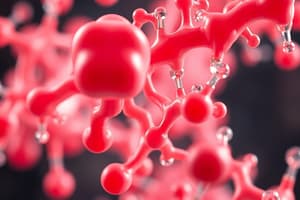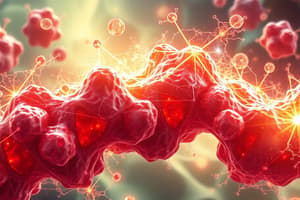Podcast
Questions and Answers
What effect does increasing substrate concentration have on enzyme action?
What effect does increasing substrate concentration have on enzyme action?
- No effect on enzyme action
- Alters enzyme structure
- Increases enzyme action (correct)
- Decreases enzyme action
At what temperature does the optimum activity for most enzymes in the human body occur?
At what temperature does the optimum activity for most enzymes in the human body occur?
- 37°C (correct)
- 45°C
- 55°C
- 25°C
What is the immediate effect of low temperatures on enzyme activity?
What is the immediate effect of low temperatures on enzyme activity?
- Enzymes become inactive
- Enzymes are enhanced
- Enzyme action slows down (correct)
- Enzymes are destroyed
Which factor significantly affects enzyme activity by causing conformational changes?
Which factor significantly affects enzyme activity by causing conformational changes?
What can occur when the pH level is outside of an enzyme's specific optimum range?
What can occur when the pH level is outside of an enzyme's specific optimum range?
What is a common example of an enzyme inhibitor found in medicine?
What is a common example of an enzyme inhibitor found in medicine?
Which metal ion is recognized as an accelerator of enzyme activity?
Which metal ion is recognized as an accelerator of enzyme activity?
What is one potential environmental hazard to enzymes derived from cigarette smoke?
What is one potential environmental hazard to enzymes derived from cigarette smoke?
Which serum enzyme level is elevated in acute pancreatitis?
Which serum enzyme level is elevated in acute pancreatitis?
The presence of which substances commonly blocks enzyme catalysis?
The presence of which substances commonly blocks enzyme catalysis?
What occurs after the substrate binds to the enzyme's active site?
What occurs after the substrate binds to the enzyme's active site?
Which theory describes the enzyme and substrate fitting together like a key and lock?
Which theory describes the enzyme and substrate fitting together like a key and lock?
What happens to the enzyme after the products are released?
What happens to the enzyme after the products are released?
Which of the following best describes activation energy?
Which of the following best describes activation energy?
In Koshland's Induced Fit Theory, what modifies the substrate or enzyme during binding?
In Koshland's Induced Fit Theory, what modifies the substrate or enzyme during binding?
What is formed during the first step of the enzymatic action?
What is formed during the first step of the enzymatic action?
What is a key feature of Fischer's Lock and Key Theory?
What is a key feature of Fischer's Lock and Key Theory?
What occurs as an outcome of the enzyme-substrate complex formation?
What occurs as an outcome of the enzyme-substrate complex formation?
How does temperature typically affect enzyme activity?
How does temperature typically affect enzyme activity?
What role do enzymes play in biochemical reactions?
What role do enzymes play in biochemical reactions?
Study Notes
Mode of Enzyme Action
- Enzyme activity begins when the substrate contacts the active site of the enzyme.
- An enzyme-substrate complex forms as a temporary intermediate.
- The substrate is converted into products within the complex.
- Products are released, and the enzyme remains unchanged, ready for another reaction.
- Activation energy is the minimum energy needed for molecules to undergo transformation.
Theories Explaining Enzyme Action
- Fischer's Lock and Key Theory: Enzyme and substrate fit together precisely like a key in a lock.
- The active site's structure is complementary to that of the substrate.
- The general reaction involves the formation and breakdown of the enzyme-substrate complex.
- Koshland's Induced Fit Theory: Suggests that binding alters the shape of the enzyme or substrate.
- Initial binding of the substrate induces conformational changes for optimal fit and catalysis.
Factors Influencing Enzyme Action
- Concentration of Substrate: Increasing substrate concentration enhances enzyme activity.
- Concentration of Enzyme: Higher enzyme concentration leads to increased reaction rates.
- Temperature:
- Optimum temperature for human enzymes is around 37°C.
- A 10°C increase can double or triple reaction rates.
- Excessive heat can inactivate enzymes, whereas low temperatures slow reactions without destroying enzymes.
- pH Level: Each enzyme has a specific pH for maximum activity, with significant decreases in activity outside this range.
- Example: Pepsin (pH 1.5 to 2.2), Lactase (pH 5.7), Trypsin (pH 7.8).
- Presence of Accelerators: Certain metallic ions (e.g., Mg, Mn, Co) can activate enzyme activity.
- Presence of Inhibitors: Substances like antibiotics or antienzymes can inhibit enzyme activity through reversible or irreversible binding.
- Environmental Hazards:
- Heavy metals such as Mercury (Hg), Cadmium (Cd), and Lead (Pb) from sources like cigarettes and gasoline can negatively affect enzyme function.
Clinical Enzymology
- Enzymes serve as analytical tools for measuring substances in biological fluids, e.g., urease and alcohol dehydrogenase.
- Enzymes are used as indicators for disease pathology.
- Elevated levels of certain enzymes, like amylase, lipase, and creatinine phosphokinase (CPK), can indicate various medical conditions (e.g., pancreatitis).
Studying That Suits You
Use AI to generate personalized quizzes and flashcards to suit your learning preferences.
Related Documents
Description
Explore the mechanisms behind enzyme action with this quiz. Learn about the formation of enzyme-substrate complexes, the theories explaining enzyme action, and factors influencing enzyme activity. Test your understanding of key concepts like Fischer's Lock and Key Theory and Koshland's Induced Fit Theory.




